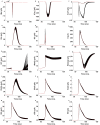A pilot study of ion current estimation by ANN from action potential waveforms
- PMID: 36372807
- PMCID: PMC9727005
- DOI: 10.1007/s10867-022-09619-7
A pilot study of ion current estimation by ANN from action potential waveforms
Abstract
Experiments using conventional experimental approaches to capture the dynamics of ion channels are not always feasible, and even when possible and feasible, some can be time-consuming. In this work, the ionic current-time dynamics during cardiac action potentials (APs) are predicted from a single AP waveform by means of artificial neural networks (ANNs). The data collection is accomplished by the use of a single-cell model to run electrophysiological simulations in order to identify ionic currents based on fluctuations in ion channel conductance. The relevant ionic currents, as well as the corresponding cardiac AP, are then calculated and fed into the ANN algorithm, which predicts the desired currents solely based on the AP curve. The validity of the proposed methodology for the Bayesian approach is demonstrated by the R (validation) scores obtained from training data, test data, and the entire data set. The Bayesian regularization's (BR) strength and dependability are further supported by error values and the regression presentations, all of which are positive indicators. As a result of the high convergence between the simulated currents and the currents generated by including the efficacy of a developed Bayesian solver, it is possible to generate behavior of ionic currents during time for the desired AP waveform for any electrical excitable cell.
Keywords: Artificial neural networks; Bayesian regularization; Cardiac action potential; Current–time dynamics; Numerical modeling.
© 2022. The Author(s), under exclusive licence to Springer Nature B.V.
Conflict of interest statement
The authors declare no competing interests.
Figures





References
-
- Van de Burgt Y, Gkoupidenis P. Organic materials and devices for brain-inspired computing: from artificial implementation to biophysical realism. MRS Bull. 2020;45(8):631–640. doi: 10.1557/mrs.2020.194. - DOI
-
- Walczak S. Artificial neural networks in medicine. Research Anthology on Artificial Neural Network Applications. 2022 doi: 10.4018/978-1-6684-2408-7.ch073. - DOI
-
- Daniel, G.: Principles of Artificial Neural Networks: Basic Designs to Deep Learning (4th ed.). World Scientific (2019)
MeSH terms
LinkOut - more resources
Full Text Sources
Research Materials
Miscellaneous

